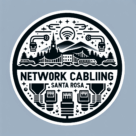Which Type of Network Cable Is Commonly Used? A Complete Guide to Networking Cables
If you’re setting up a home or office network, you might be wondering: which type of network cable is commonly used and why. Choosing the right cable can make a big difference in network speed, reliability, and future-proofing.
In this guide, we’ll explain the most commonly used network cables, what makes them popular, and how to choose the right one for your needs. Our team of network cabling professionals in Santa Rosa ensures every installation uses the most reliable and high-performance cables for your connectivity needs.
What Is a Network Cable?
A network cable is a physical medium that connects devices like computers, routers, switches, and servers to create a wired network. Wired networks are typically faster and more stable than Wi-Fi, especially in areas with high device density or thick walls.
The most commonly used network cables today are twisted pair Ethernet cables, with categories like Cat5e, Cat6, and Cat6a dominating homes and businesses.
Why Twisted Pair Cables Are the Most Common
Twisted pair cables consist of copper wires twisted together to reduce interference. They are inexpensive, easy to install, and meet the speed needs of most modern networks.
Two main types of twisted pair cables are:
- Unshielded Twisted Pair (UTP): The most widely used, flexible, and affordable option for homes and offices.
- Shielded Twisted Pair (STP): Provides additional protection against electromagnetic interference, usually in industrial or high-interference environments.
Because of their balance of cost, performance, and ease of installation, UTP cables like Cat5e and Cat6 are the standard choice for most wired networks.
Popular Network Cable Categories
Here’s a quick look at the most common Ethernet cable categories:
- Cat5e (Category 5 Enhanced):
Supports up to 1 Gbps speeds, sufficient for most home and office networks. It’s affordable and still widely installed in existing networks. - Cat6 (Category 6):
Supports up to 10 Gbps over shorter distances (up to 55 meters) and reduces crosstalk better than Cat5e. Ideal for modern homes and small offices. - Cat6a (Augmented Category 6):
Supports 10 Gbps over 100 meters with improved shielding. Used in enterprise networks or situations where future-proofing is important.
Other cable types like coaxial cables and fiber-optic cables are less common for everyday home or office LANs but are still important for backbone or long-distance connections.
Why These Cables Are So Common
The popularity of Cat5e and Cat6 cables comes from several factors:
- Cost-effective: Affordable without sacrificing performance for typical needs.
- Compatibility: Works with most routers, switches, and devices.
- Ease of installation: Flexible, easy to terminate, and widely supported.
- Reliable performance: Handles typical home and office network demands, including streaming, gaming, and VoIP.
Even as higher-performance cables like Cat6a and fiber grow in popularity, Cat5e and Cat6 remain the go-to choices for most installations.
Where Common Network Cables Make the Biggest Difference
Using the right network cable matters most in:
- Home offices or apartments: Stable wired connections for computers, smart TVs, and gaming consoles.
- Small and medium offices: Reliable connections for workstations, printers, VoIP phones, and Wi-Fi access points.
- Large buildings or multi-floor setups: Structured cabling with Cat6 or Cat6a ensures consistent performance across long runs.
Even if your Wi-Fi is strong, a wired connection using common Ethernet cables can dramatically improve speed and reliability for high-demand devices.
How to Choose the Right Network Cable
Here are a few tips:
- Consider your speed needs: Cat5e is fine for 1 Gbps; Cat6 or Cat6a if you want 10 Gbps or better future-proofing.
- Check compatibility: Make sure the cable works with your router, switch, and devices.
- Think about distance: Longer runs may require higher-category cables to maintain performance.
- Plan for the future: Upgrading to Cat6 or Cat6a may save you from re-cabling later.
Professional installation is optional for small setups, but larger networks benefit from certified installers who can test and label each connection for optimal performance. While Cat6 and Cat7 are among the most used options today, you might also want to explore what the fastest network cable is for top-speed data transmission.
Upgrade Your Network Today
Choosing the right network cable is a simple but impactful way to improve your home or office network. Cat5e and Cat6 cables are the most commonly used because they balance speed, cost, and reliability, making them ideal for most setups.
Whether you’re streaming movies, gaming online, or running multiple devices in your office, using the right cable ensures your network runs smoothly and efficiently.
Contact your local networking experts in California to learn how choosing the right network cable can boost your home or business network today.
